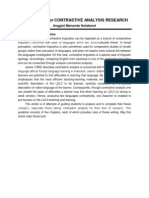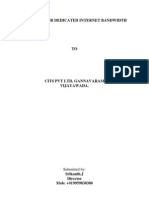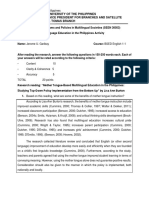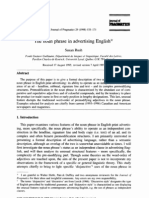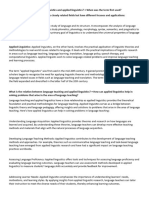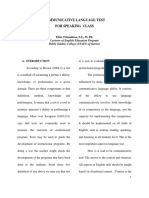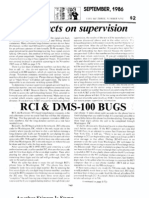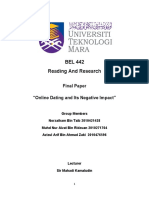100%(1)100% found this document useful (1 vote)
341 viewsReading For Gist
Reading For Gist
Uploaded by
Hafidhah RazaliThe GIST (Generating Interaction Schemata and Text) strategy is used to improve student comprehension and summarization of main ideas. It was developed to help students briefly summarize paragraphs. GIST involves identifying who, what, when, where, why and how in a paragraph and combining this into a 10-20 word summary. Some benefits of GIST include improving reading comprehension, activating prior knowledge, and helping with exams. GIST can be applied individually or in cooperative groups.
Copyright:
© All Rights Reserved
Available Formats
Download as PPTX, PDF, TXT or read online from Scribd
Reading For Gist
Reading For Gist
Uploaded by
Hafidhah Razali100%(1)100% found this document useful (1 vote)
341 views10 pagesThe GIST (Generating Interaction Schemata and Text) strategy is used to improve student comprehension and summarization of main ideas. It was developed to help students briefly summarize paragraphs. GIST involves identifying who, what, when, where, why and how in a paragraph and combining this into a 10-20 word summary. Some benefits of GIST include improving reading comprehension, activating prior knowledge, and helping with exams. GIST can be applied individually or in cooperative groups.
Original Description:
Reading for gist
Original Title
Reading for gist
Copyright
© © All Rights Reserved
Available Formats
PPTX, PDF, TXT or read online from Scribd
Share this document
Did you find this document useful?
Is this content inappropriate?
The GIST (Generating Interaction Schemata and Text) strategy is used to improve student comprehension and summarization of main ideas. It was developed to help students briefly summarize paragraphs. GIST involves identifying who, what, when, where, why and how in a paragraph and combining this into a 10-20 word summary. Some benefits of GIST include improving reading comprehension, activating prior knowledge, and helping with exams. GIST can be applied individually or in cooperative groups.
Copyright:
© All Rights Reserved
Available Formats
Download as PPTX, PDF, TXT or read online from Scribd
Download as pptx, pdf, or txt
100%(1)100% found this document useful (1 vote)
341 views10 pagesReading For Gist
Reading For Gist
Uploaded by
Hafidhah RazaliThe GIST (Generating Interaction Schemata and Text) strategy is used to improve student comprehension and summarization of main ideas. It was developed to help students briefly summarize paragraphs. GIST involves identifying who, what, when, where, why and how in a paragraph and combining this into a 10-20 word summary. Some benefits of GIST include improving reading comprehension, activating prior knowledge, and helping with exams. GIST can be applied individually or in cooperative groups.
Copyright:
© All Rights Reserved
Available Formats
Download as PPTX, PDF, TXT or read online from Scribd
Download as pptx, pdf, or txt
You are on page 1of 10
Reading for gist
What is GIST ?
GIST (Generating Interaction Schemata and Text)
Strategy is a summarization strategy that will
improve students’ abilities to comprehend and
summarize the gist or main idea of paragraph.
The Generating Interactions between Schemata and
Text (GIST) Strategy Is developed by Cunningham
(2001) in order to assist students in briefly
summarizing paragraphs
Definition of Gist Strategy
Harrel (2000:250) state that GIST is a strategy for
supporting comprehension of informational text.
GIST is especially helpful when students are required
to read long texts that contain a significant amount
of new information
Wright (2011:1) notices that gist was used in
teaching reading because gist was a good strategy for
any level reader and the students develop skills in
identifying main ideas and key concepts in the text.
Procedures of Gist Strategy
a. Step 1 Choose an informational paragraph from a
science, history, etc. textbook.
b. Step 2 Continue reading and demonstrate picking out
the who, what, when, where, why of the paragraph and
related important information.
c. Step 3 Demonstrate pulling together the above
information into a 10 until 20-words “gist” or summary.
d. Step 4 In pairs, guide students in completing a “gist”
sheet or “Sum It Up” sheet. Support students in creating
summaries until they can do them independently
Some advantages of using Gist Strategy
According to Putri (2014:37), there were some main
advantages that could be obtained from gist strategy
1. It could improve reading comprehension as well as
summary writing
2. Gist strategy could active students‟ prior knowledge
3.This strategy could help the students in final
examination
4. Gist strategy could revise and refine vocabulary as
well.
GIST strategy can be applied in cooperative groups. Working in
cooperative group can be applied if the students already familiar with
the process.
The steps follow here by Bouchard (2005: 41):
1) Assign a section of text for students to read.
2) Form groups and assign a group leader.
3) Students read the text silently (or a group member can read it aloud).
4) The group collaboratively identifies important vocabulary and concepts
based on setting, event, character and character’s problem.
5) The group develops the summary statement identifying the gist of the
reading.
6) Each member of the group writes the summary statement
on a piece of paper.
7) The group reads the next portion of text and repeats the
process.
8) Move from group to group observing and providing
support when needed.
9) Each group presents its summary statement(s).
10) Discuss as a class and compare.
Get The Gist!
Name: ________Topic: ______ Pages: ______
1. Read the page or section of the textbook.
2. Fill in the 5Ws and 1H you found out from your reading.
Who:
What:
When:
Where:
Why:
How:
3. Write a 20-word GIST summary.
______________ ______________ _______________ ______________ ____________
______________ ______________ _______________ ______________ ____________
______________ ______________ _______________ ______________ ____________
______________ ______________ _______________ ______________ ____________
Referencess
Bouchard, Margaret. 2005. Comprehension Strategies for English Language
Learners.USA: Scholastic Inc.
Cunningham. 2001. Description,Rationale, Instruction moves, and References for
Generating Interactions between Schemata and Text (GIST).
Harrel, Adrienne. L. 2000. Fifty Strategies for Teaching English Language Learners. New
Jersey: Prantice-Hall Inc.
Putri, Yulia Agustiara 2014. The Implementation of Get the Gist Strategy in Improving
Students' Reading comprehension Achievement of Recount Text at the Second Grade of
SMPN 13 Bandar Lampung. Fakultas Keguruan dan Ilmu Pendidikan, Universitas
Lampung.
Wright, B. 2011. Stop Complaining and Get the Gist. http://(education.ucf.edu/
litsymposium/resources2012/Stopcomplainingandgetthegist.pdf). Retrieved on
November 25 nd , 2021.
You might also like
- Korean Language Module 1Document12 pagesKorean Language Module 1Leonisa Macalindong100% (6)
- Communication in Small Groups PDFDocument2 pagesCommunication in Small Groups PDFQuentinNo ratings yet
- Diagnostic Grade 12Document2 pagesDiagnostic Grade 12Jenelle de VeraNo ratings yet
- 2739 Chapter 3 Exercises and Answer Key.Document3 pages2739 Chapter 3 Exercises and Answer Key.luihwangNo ratings yet
- văn học anh mỹ - bản hoàn chỉnhDocument20 pagesvăn học anh mỹ - bản hoàn chỉnhOh ShidNo ratings yet
- A Guideline For Contrastive Analysis ResearchDocument5 pagesA Guideline For Contrastive Analysis ResearchParlindungan Pardede100% (1)
- Nominal Group in EnglishDocument5 pagesNominal Group in EnglishEdrine Enterina Petalcorin100% (1)
- MID-YEAR REVIEW FORM (MRF) For Master Teacher I-IVDocument7 pagesMID-YEAR REVIEW FORM (MRF) For Master Teacher I-IVleaflor malangis80% (15)
- Nature and Elements of CommunicationDocument3 pagesNature and Elements of CommunicationDherick Raleigh75% (8)
- Proposal For Dedicated Internet BandwidthDocument3 pagesProposal For Dedicated Internet Bandwidthjsri100% (1)
- DLL CHS Grade 10Document5 pagesDLL CHS Grade 10Guguk Orquejo100% (3)
- Anaphora, Cataphora, EndophoraDocument3 pagesAnaphora, Cataphora, EndophoraCelestineNo ratings yet
- English Syntax-Presentation TopicsDocument1 pageEnglish Syntax-Presentation Topicsakbar goak3No ratings yet
- Linguistic 1 - Compounding and BlendingDocument16 pagesLinguistic 1 - Compounding and BlendingNguyễn Thị HằngNo ratings yet
- Introduction - Describing and Explaining L2 AcquisitionDocument2 pagesIntroduction - Describing and Explaining L2 AcquisitionKha WlaNo ratings yet
- Academic Reading & Writing - Types of EssayDocument17 pagesAcademic Reading & Writing - Types of EssayMuhammad Junaid100% (1)
- Course Outline - English LiteratureDocument2 pagesCourse Outline - English LiteratureLiljana DimeskaNo ratings yet
- Variability in Inter LanguageDocument18 pagesVariability in Inter Languagemikahangai100% (5)
- 10 Genre in TranslationDocument19 pages10 Genre in TranslationMáirtín Ó hUallacháinNo ratings yet
- Key Terms in ELTDocument10 pagesKey Terms in ELTSalsabeel Nagi100% (1)
- LPPMS Lesson 3 Activity Garibay JeromeDocument4 pagesLPPMS Lesson 3 Activity Garibay JeromeJerome GaribayNo ratings yet
- Scmitt VLS Taxonomy PDFDocument7 pagesScmitt VLS Taxonomy PDFEvelin ĐilvesiNo ratings yet
- Prefixes and Suffixes - Advanced EnglishDocument8 pagesPrefixes and Suffixes - Advanced EnglishreslansabahNo ratings yet
- Teaching Language SkillsDocument6 pagesTeaching Language Skillsfatihgun007No ratings yet
- LESSON: Adapting Courses A Personal View Pre - DiscussionDocument4 pagesLESSON: Adapting Courses A Personal View Pre - DiscussionRayshane EstradaNo ratings yet
- Writing Guides From BBC Skills WiseDocument6 pagesWriting Guides From BBC Skills WisedanielamuncaNo ratings yet
- Leech 2007 StyleDocument20 pagesLeech 2007 StyleHery Pramono Wibowo100% (1)
- 2nd Group - Textual Equivalence Cohesion IIDocument13 pages2nd Group - Textual Equivalence Cohesion IIYanti DakhiNo ratings yet
- Assessing Grammar and VocabularyDocument6 pagesAssessing Grammar and VocabularyIsabel Jiménez GómezNo ratings yet
- Eliciting Vocabulary and Checking UnderstandingDocument1 pageEliciting Vocabulary and Checking UnderstandingThuy (AEKT-AMES-HVT) Dang ThiNo ratings yet
- Chapter 2-Teaching ReadingDocument19 pagesChapter 2-Teaching ReadingNguyen Ngoc Kim Ngan B1800206No ratings yet
- EXERCISES OF UNIT 2 - SociolinguisticDocument1 pageEXERCISES OF UNIT 2 - SociolinguisticTuan NguyenNo ratings yet
- Aim and Function of Text (Functional English)Document3 pagesAim and Function of Text (Functional English)shaharhamestate100% (1)
- Indian English PresentationDocument16 pagesIndian English Presentationevelina_turcule4939No ratings yet
- The Noun Phrase in Ads EnglishDocument17 pagesThe Noun Phrase in Ads EnglishMemay ManiemanyNo ratings yet
- Introduction To Translation 1.1 What Is Translation?Document5 pagesIntroduction To Translation 1.1 What Is Translation?Desi KatrinaNo ratings yet
- Lecture 5Document70 pagesLecture 5Ngo Thu HienNo ratings yet
- Practice With Topic Sentences 1Document4 pagesPractice With Topic Sentences 1Đỗ LinhNo ratings yet
- Final Exam - Intercultural Communication - 23 PAC 1 TP & 2 TP - 25 Jan 2022Document2 pagesFinal Exam - Intercultural Communication - 23 PAC 1 TP & 2 TP - 25 Jan 2022Michelle Kwan -No ratings yet
- Group 5 Syllabus Process and Product Oriented SyllabusDocument34 pagesGroup 5 Syllabus Process and Product Oriented SyllabusEva S. SyahvitriNo ratings yet
- FILE - 20210618 - 112644 - Tailieu Mon ICDocument80 pagesFILE - 20210618 - 112644 - Tailieu Mon ICVõ Thị Ngân TâmNo ratings yet
- What Is The Difference Between Linguistics and Applied LinguisticsDocument3 pagesWhat Is The Difference Between Linguistics and Applied LinguisticsSeba OilherNo ratings yet
- Stylistics SyllabusDocument5 pagesStylistics SyllabusCrystalVelezNo ratings yet
- The Adventures of Huckkleberry Finn ScriptDocument3 pagesThe Adventures of Huckkleberry Finn ScriptZi XuanNo ratings yet
- Communicative Language Test PDFDocument14 pagesCommunicative Language Test PDFIsnaPurnama100% (1)
- Understanding Constructivism in The Second Language Learning ContextDocument20 pagesUnderstanding Constructivism in The Second Language Learning ContextAnonymous CwJeBCAXpNo ratings yet
- American Literature Practice TestDocument6 pagesAmerican Literature Practice TestseethuryaNo ratings yet
- Ellipsis and SubstitutionDocument12 pagesEllipsis and Substitutionélton100% (1)
- Economics BSDocument183 pagesEconomics BSDomestic RecyclingNo ratings yet
- Chapter 3 - BorrowingDocument5 pagesChapter 3 - BorrowingElisaZhangNo ratings yet
- Implicit, Explicit, and MetalanguageDocument14 pagesImplicit, Explicit, and MetalanguageJean Alric AlmiraNo ratings yet
- Analysis of Students Errors in Writing SDocument17 pagesAnalysis of Students Errors in Writing SAnonymous NSl5AMNo ratings yet
- Language Features of A Critical ReviewDocument2 pagesLanguage Features of A Critical ReviewCristinaCrisNo ratings yet
- Fairclough's 3D Model: BackgroundDocument4 pagesFairclough's 3D Model: BackgroundSalsabeel Nagi100% (1)
- Language Variations Report Compilation PDFDocument128 pagesLanguage Variations Report Compilation PDFWawy TorremochaNo ratings yet
- (123doc) - Phan-Tich-Tac-Pham-Analyze-Flight-By-Doris-LessingDocument11 pages(123doc) - Phan-Tich-Tac-Pham-Analyze-Flight-By-Doris-LessingMinh Thuận Hoàng ThịNo ratings yet
- Assignment#1 Reading ComprehensionDocument4 pagesAssignment#1 Reading Comprehensionpipo100% (1)
- Language Assessment, Brown & Abeywickrama (2019) - Chapter 1 SummaryDocument3 pagesLanguage Assessment, Brown & Abeywickrama (2019) - Chapter 1 SummaryCông Định NguyễnNo ratings yet
- Most Common Usage ProblemsDocument9 pagesMost Common Usage ProblemssolielcervantesNo ratings yet
- The Direct Method of TeachingDocument4 pagesThe Direct Method of TeachingRooby Stephanie100% (1)
- Summary How To Teach PronunciationDocument5 pagesSummary How To Teach PronunciationAndres Felipe REYES PARRALESNo ratings yet
- Introduction To Discourse AnalysisDocument6 pagesIntroduction To Discourse AnalysisAnca HalaszNo ratings yet
- M1 W7 Discourse Analysis (These Notes Ran Over Two Slots in The F2F Version)Document19 pagesM1 W7 Discourse Analysis (These Notes Ran Over Two Slots in The F2F Version)Mahmoud YousefNo ratings yet
- Unit 6: Syllabus Design: Module 1 (1 of 1)Document3 pagesUnit 6: Syllabus Design: Module 1 (1 of 1)Sheethal Sarma100% (1)
- GISTDocument3 pagesGISTNathalia ChávezNo ratings yet
- FINAL Sample Paper-Grade 4-MixDocument3 pagesFINAL Sample Paper-Grade 4-MixManikaUpadhyayaChaturvediNo ratings yet
- Change Management & Study To ChangeDocument8 pagesChange Management & Study To ChangeFaizan ChNo ratings yet
- Axis Gatepass Brochure PDFDocument4 pagesAxis Gatepass Brochure PDFaroravikasNo ratings yet
- 2600: The Hacker Quarterly (Volume 3, Number 9, September 1986)Document8 pages2600: The Hacker Quarterly (Volume 3, Number 9, September 1986)Ranko Kohime100% (1)
- Two Step Flow TheoryDocument3 pagesTwo Step Flow TheoryLois StanleyNo ratings yet
- ABEL 113: Journalistic WritingDocument259 pagesABEL 113: Journalistic WritingKane100% (1)
- Roles Ngo EduDocument2 pagesRoles Ngo EduCabdiqaadir Qaasim AadanNo ratings yet
- BEL 442 Final PaperDocument16 pagesBEL 442 Final PaperAizat RidzuanNo ratings yet
- Critical Reading: Rozi Khan Asst. Professor of EnglishDocument15 pagesCritical Reading: Rozi Khan Asst. Professor of English12f1978No ratings yet
- g7 Atl Mapping For Report Card BahieDocument7 pagesg7 Atl Mapping For Report Card Bahieapi-411562137No ratings yet
- Dangelo TeachingcvDocument2 pagesDangelo Teachingcvapi-318909348No ratings yet
- Illegal - Content Kopie FDCServersDocument7 pagesIllegal - Content Kopie FDCServersAnonymous sZLdZ48No ratings yet
- Balance Literacy ProgramDocument2 pagesBalance Literacy ProgramCassSilva89No ratings yet
- The Northcap University Internship Report: TOPIC: Digital Marketing ManagementDocument11 pagesThe Northcap University Internship Report: TOPIC: Digital Marketing ManagementChirag GodaraNo ratings yet
- QRF TexasDocument2 pagesQRF TexasMelinda PandianganNo ratings yet
- Project Report Vaibhav Aneja CorrectedDocument76 pagesProject Report Vaibhav Aneja CorrectedRajnish RajNo ratings yet
- Language Ecology Sociolinguistic Environment Contact and DynamicsDocument10 pagesLanguage Ecology Sociolinguistic Environment Contact and Dynamicssharma_maansiNo ratings yet
- Unit-2 NotesDocument20 pagesUnit-2 Notesamitkumarpal2571No ratings yet
- BhelaDocument10 pagesBhelaPunitha MohanNo ratings yet
- Session2 Sl2cce417 PDFDocument23 pagesSession2 Sl2cce417 PDFlunaNo ratings yet
- SEO SlidesDocument53 pagesSEO SlidesPrashant SinhaNo ratings yet
- Philosophy Statement 1Document2 pagesPhilosophy Statement 1api-510895249No ratings yet
- CGMartin OCModule4Document5 pagesCGMartin OCModule4Cloie Irish MartinNo ratings yet
- Visual Communication Assessment in PhotographyDocument20 pagesVisual Communication Assessment in PhotographymanishshakticommunicNo ratings yet





